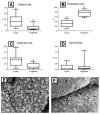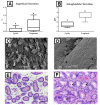Histomorphometric and vascular changes in equine endometrium after the infusion of conceptus fragments
- PMID: 32714458
- PMCID: PMC7375867
- DOI: 10.1590/1984-3143-AR2020-0006
Histomorphometric and vascular changes in equine endometrium after the infusion of conceptus fragments
Abstract
This experiment aimed to verify if the proteins present in a 13th day conceptus induce changes in the equine endometrial ultra-structure, histology, and vascularization, two days after its infusion. Ten healthy cyclic mares were used. Once estrus was confirmed, mares were examined daily to detect ovulation (day 0). After ovulation, mares were examined daily until day seven by transrectal palpation and B-mode and Doppler ultrasonography. In this first cycle, intrauterine biopsies were collected at day seven after ovulation, constituting the Cyclic group (n = 10). In the second cycle, the same mares daily were examined until ovulation was detected. After ovulation, mares were examined daily by transrectal palpation and B-mode and Doppler ultrasonography until day 7. On day 5, after ovulation, fragments from previously collected 13-day-old concepti were infused into the uterus of each mare. Intrauterine biopsies were collected at day 7 in all mares (n = 10), constituting the Fragment group. The percentage of ciliated and flattened cells decreased in the Fragment group. Protruded cells, superficial and intraglandular secretion, glandular lumen and diameter, blood vessel diameter, endometrial vascularization, and immune cells were higher in the Fragment group than in the Cyclic group. In summary, proteins of 13th day equine conceptus fragments infused at day five after ovulation signaled histological and vascular changes in the endometrium at the 7th day after ovulation.
Keywords: histological; ultrastructure; uterus; vascularization.
Copyright © The Author(s).
Conflict of interest statement
Conflicts of interest: The authors have no conflict of interest to declare.
Figures






References
-
- Ball B, Altschul M, Hillman R. Luteal maintenance in mares after transfer of equine trophoblastic vesicles. Equine Vet J. 1989;21(S8):21–24. doi: 10.1111/j.2042-3306.1989.tb04667.x. - DOI
LinkOut - more resources
Full Text Sources
